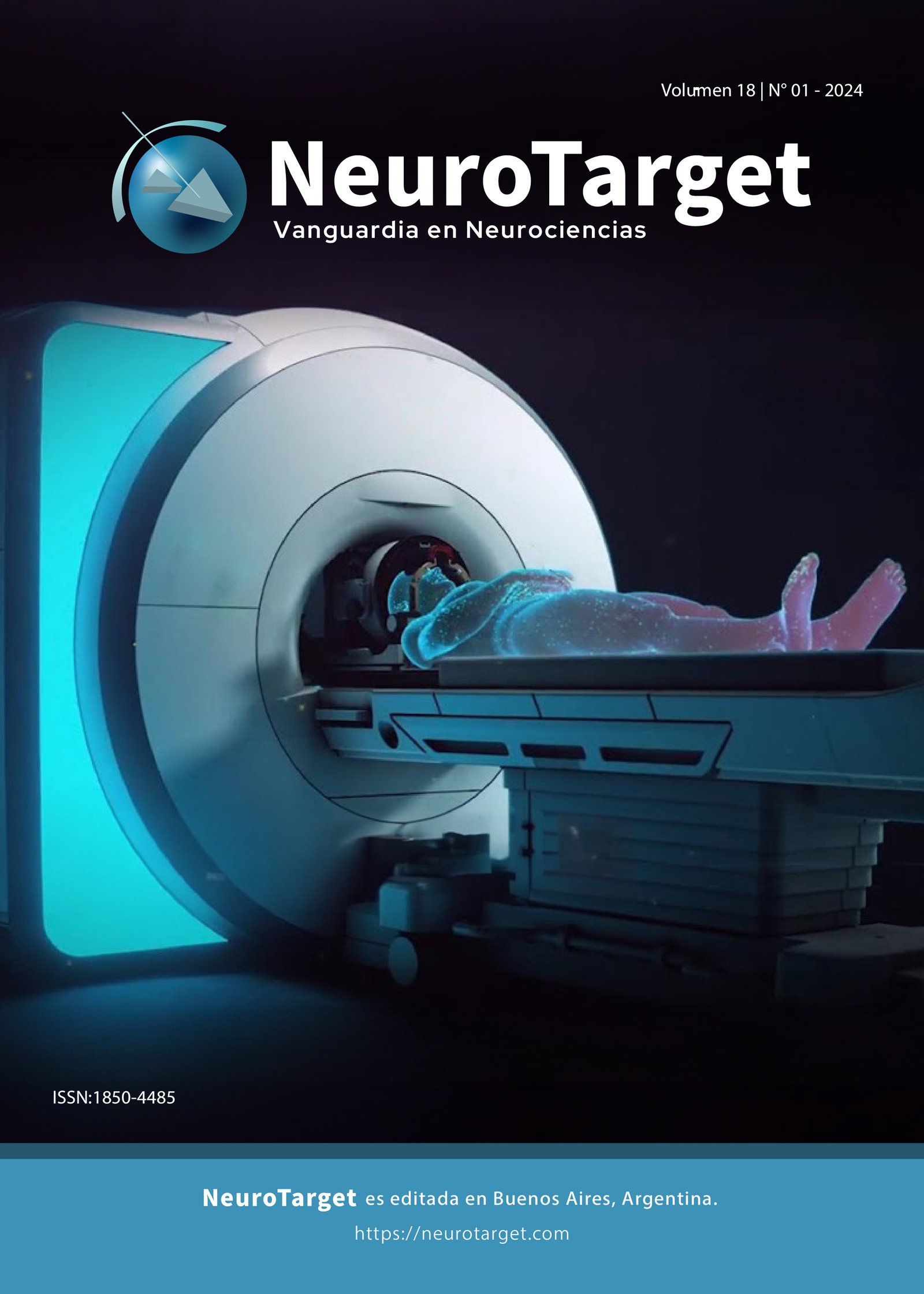Transcranial Magnetic Stimulation. Introduction to its principles and fundamentals
DOI:
https://doi.org/10.47924/neurotarget2024467Keywords:
transcranial magnetic stimulation, neuromodulation, neurostimulation, tms, cerebral cortex, depressionAbstract
Transcranial magnetic stimulation (TMS) and its repetitive form (rTMS) are noninvasive tools used to modify the excitability of the cerebral cortex and its underlying circuits from electrical stimuli, using electromagnetic fields generated by a coil on the scalp. Currently, single-pulse TMS has established itself as an essential technique for neuroscience research, while rTMS, thanks to its ability to induce sustained neuromodulation, has expanded the purposes of the technique in diagnosis, also demonstrating its usefulness in the therapy of various neurological and psychiatric pathologies.
The transition from being an experimental tool to an established diagnostic and therapeutic technique has allowed thousands of patients to benefit annually from its capacity to treat various symptoms or its ability to map critical brain areas before surgical interventions, among other applications.
We propose here a series of reviews to offer a rigorous and updated synthesis on the use of TMS, not only in the pathologies and symptoms in which it is applied, but also delving into the neurobiological bases that support these indications
This article addresses the physical and neurophysiological foundations of TMS, with special emphasis on the stimulation parameters that determine its efficacy, as well as the main modalities and indications used both in research and in clinical practice. The underlying mechanisms that explain the effects of TMS on cortical excitability and functional neural networks will also be explored.
Metrics
References
Faraday M. Experimental Researches in Electricity. Phil. Trans. R. Soc. 1832;122:125–162. Available from: http://archive.org/details/philtrans01461252
Tesla N. Experiments with Alternate Currents of High Potential and High Frequency. A Lecture Delivered before the Institution of Electrical Engineers, London. 2004. Available from: https://www.gutenberg.org/ebooks/13476
Basser PJ, Roth BJ. New currents in electrical stimulation of excitable tissues. Annu Rev Biomed Eng. 2000;2:377-97. doi: 10.1146/annurev.bioeng.2.1.377.
Barker AT, Jalinous R, Freeston IL. Non-invasive magnetic stimulation of human motor cortex. Lancet. 1985;1(8437):1106-1107. doi:10.1016/s0140-6736(85)92413-4.
Hallett M. Transcranial magnetic stimulation: a primer. Neuron. 2007. 19;55(2):187-99. doi: 10.1016/j.neuron.2007.06.026.
Roth BJ, Cohen LG, Hallett M, Friauf W, Basser PJ. A theoretical calculation of the electric field induced by magnetic stimulation of a peripheral nerve. Muscle Nerve. 1990;13(8):734-41. doi:10.1002/mus.880130812.
Opitz A, Paulus W, Will S, Antunes A, Thielscher A. Determinants of the electric field during transcranial direct current stimulation. Neuroimage. 2015;109:140-150. doi:10.1016/j.neuroimage.2015.01.033
Ziemann U, Tergau F, Wassermann EM, Wischer S, Hildebrandt J, Paulus W. Demonstration of facilitatory I wave interaction in the human motor cortex by paired transcranial magnetic stimulation. J Physiol. 1998; 511:181-190. doi:10.1111/j.1469-7793.1998.181bi.x
Massimini M, Ferrarelli F, Huber R, Esser SK, Singh H, Tononi G. Breakdown of cortical effective connectivity during sleep. Science. 2005;309(5744):2228-2232. doi:10.1126/science.1117256
Bergmann TO, Mölle M, Schmidt MA, et al. EEG-guided transcranial magnetic stimulation reveals rapid shifts in motor cortical excitability during the human sleep slow oscillation. J Neurosci. 2012;32(1):243-253. doi:10.1523/JNEUROSCI.4792-11.2012
Allen EA, Pasley BN, Duong T, Freeman RD. Transcranial magnetic stimulation elicits coupled neural and hemodynamic consequences. Science. 2007;317 (5846):1918-1921. doi:10.1126/science.1146426
Esser SK, Hill SL, Tononi G. Modeling the effects of transcranial magnetic stimulation on cortical circuits. J Neurophysiol. 2005;94(1):622-639. doi:10.1152/jn.01230.2004
Siebner HR, Funke K, Aberra AS, et al. Transcranial magnetic stimulation of the brain: What is stimulated? - A consensus and critical position paper. Clin Neurophysiol.2022;140:59-97. doi:10.1016/j.clinph.2022.04.022
Pascual-Leone A, Valls-Solé J, Wassermann EM, Hallett M. Responses to rapid-rate transcranial magnetic stimulation of the human motor cortex. Brain. 1994;117(Pt 4):847-858. doi:10.1093/brain/117.4.847
George MS, Wassermann EM, Williams WA, et al. Daily repetitive transcranial magnetic stimulation (rTMS) improves mood in depression. Neuroreport. 1995;6(14): 1853-1856. doi:10.1097/00001756-199510020-00008
Bystritsky A, Kaplan JT, Feusner JD, et al. A preliminary study of fMRI-guided rTMS in the treatment of generalized anxiety disorder. J Clin Psychiatry. 2008;69 (7):1092-1098. doi:10.4088/jcp.v69n0708
Sayın S, Cakmur R, Yener GG, Yaka E, Uğurel B, Uzunel F. Low-frequency repetitive transcranial magnetic stimulation for dyskinesia and motor performance in Parkinson's disease. J Clin Neurosci. 2014;21(8):1373-1376. doi:10.1016/j.jocn.2013.11.025
Huang YZ, Edwards MJ, Rounis E, Bhatia KP, Rothwell JC. Theta burst stimulation of the human motor cortex. Neuron. 2005;45(2):201-206. doi:10.1016/j.neuron.2004.12.033
Chung SW, Hoy KE, Fitzgerald PB. Theta-burst stimulation: a new form of TMS treatment for depression?. Depress Anxiety. 2015;32(3):182-192. doi:10.1002/da.22335
Cole EJ, Stimpson KH, Bentzley BS, Gulser M, Cherian K, Tischler C, et al. Stanford Accelerated Intelligent Neuromodulation Therapy for Treatment-Resistant Depression. American Journal of Psychiatry. 2020;177(8):716-726. doi:10.1176/appi.ajp.2019.19070720
Rossini PM, Burke D, Chen R, Cohen LG, Daskalakis Z, Di Iorio R, et al. Non-invasive electrical and magnetic stimulation of the brain, spinal cord, roots and peripheral nerves: Basic principles and procedures for routine clinical and research application. An updated report from an I.F.C.N. Committee. Clin Neurophysiol. 2015;126(6): 1071-1107. doi: 10.1016/j.clinph.2015.02.001.
O'Reardon JP, Solvason HB, Janicak PG, Sampson S, Isenberg KE, Nahas Z, et al. Efficacy and safety of transcranial magnetic stimulation in the acute treatment of major depression: a multisite randomized controlled trial. Biol Psychiatry. 2007;62(11):1208-16. doi: 10.1016/j.biopsych.2007.01.018.
Deng ZD, Lisanby SH, Peterchev AV. Electric field depth–focality tradeoff in transcranial magnetic stimulation: Simulation comparison of 50 coil designs. Brain Stimulation. 2013; 6(1):1–13.
Wassermann EM. Risk and safety of repetitive transcranial magnetic stimulation: report and suggested guidelines from the International Workshop on the Safety of Repetitive Transcranial Magnetic Stimulation, June 5-7, 1996. Electroencephalogr Clin Neurophysiol. 1998; 108(1):1-16. doi:10.1016/s0168-5597(97)00096-8
Siebner HR, Rothwell J. Transcranial magnetic stimulation: new insights into representational cortical plasticity. Exp Brain Res. 2003;148(1):1-16. doi:10.1007/s00221-002-1234-2
Herwig U, Satrapi P, Schönfeldt-Lecuona C. Using the international 10-20 EEG system for positioning of transcranial magnetic stimulation. Brain Topogr. 2003;16(2):95-99. doi:10.1023/b:brat.0000006333.93597.9d
Lefaucheur JP, Aleman A, Baeken C, Benninger DH, Brunelin J, Di Lazzaro V, et al. Evidence-based guidelines on the therapeutic use of repetitive transcranial magnetic stimulation (rTMS): An update (2014-2018). Clin Neurophysiol. 2020;131(2):474–528.
Downloads
Published
How to Cite
Issue
Section
License
Copyright (c) 2024 Franco Moscovicz

This work is licensed under a Creative Commons Attribution 4.0 International License.
The article is distributed under the Creative Commons Attribution 4.0 License. Unless otherwise stated, associated published material is distributed under the same licence.







